FIRST BORN
The birth, life, and death of an industrial nation
Everyone knows about the industrial revolution, when industry sprang from the green fields of the west midlands. What I want to emphasise in these pages is the long lead-in to industrialisation. It is becoming more accepted by historians that industrialisation in Britian during the 18th and 19th centuries was not a revolution, but an accelerated evolution. Britain was the first country to industrialise, which was an advantage to start with, but became a disadvantage as machinery and buildings needed replacing. It continued as an industrial nation until after the second world war, when services became a more important contributor to gross domestic product. It is now largely an economy based on weightless goods such as computer software, particularly electronic games, and services.
To aid understanding of accelerated evolution, I am first going to describe the various aspects of growth that are found in the natural and man-made worlds.
Growth
Time isn’t the main thing. It’s the only thing. Miles Davis
Whether it’s the best of times or the worst of times, it’s the only time we’ve got. Art Buchwald
We should always allow some time to elapse, for time discloses the truth. Seneca
Time is the devourer of everything. Ovid
Growth is fundamental to life on earth. All living things, and some non-living things, grow at some stage in their life and time is fundamental to growth. I will not be looking in detail at the growth of non-living things, like mountains, volcanic islands and the like. Instead, I will describe the various types of growth for living things.
Growth can be split into two basic types, linear and non-linear. 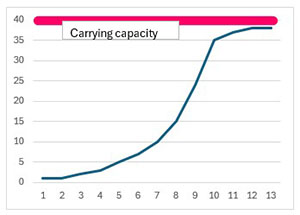 Linear growth is easy to describe; it is the same unit of growth for each unit of time and, if graphed, will give you a straight line.
Linear growth is easy to describe; it is the same unit of growth for each unit of time and, if graphed, will give you a straight line.
Non-linear growth comes in different types. For living things, the usual form of growth is logistic. It assumes growth in an environment with limited recourses. This is a S-shaped curve that tops out at the carrying capacity of the environment.
Without the topping out, we have exponential growth. Cancers and atomic chain reactions grow like this.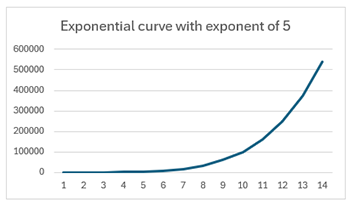 It is called exponential growth, because it grows according to the following formula. Y = Xexp, in our example Y = X5.
It is called exponential growth, because it grows according to the following formula. Y = Xexp, in our example Y = X5.
Thomas Malthus, an 18th century economist and demographer, was very worried that population growth seemed to be exponential, but agricultural yields were only growing linearly. This would lead to starvation and a reduced population. He was right about population growth being exponential in his lifetime, but the very large decrease in birthrates in the latter part of the 20th century suggest that it is logistic and will top out somewhere between 13 and 14 billion, with perhaps some decline after that. That is assuming we don’t heat the planet with CO2 emissions enough to make human life impossible.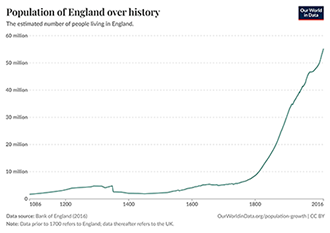
Malthus also miscalculated our ability to increase the productivity of agriculture. The chart of U.K. cereal yields shows yields growing exponentially between 1900 and 2000, but it looks like there are starting to top out in 2023. Both these charts were downloaded from Our World in Data
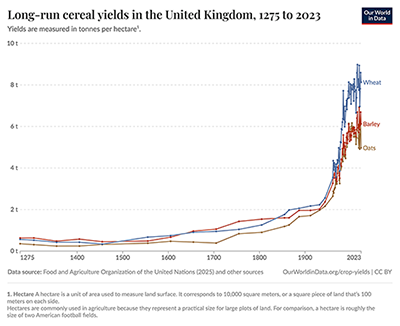
What neither the population chart or the cereal chart can tell us is whether the top of the logistics curve is below or above the sustainable carrying capacity of the planet. We can probably do something about cereal production using genetic engineering, but population looks more of a problem. There are vast inequalities of wealth and income in the world. Currently, each person on Earth could have, constantly available, close to 30 Kilojoules of energy, provided by coal, oil, gas and electricity. Translated into the human power used for most of history, that works out to some 60 servants per person. In affluent countries in the Northern hemisphere, we each, on average, have some 200 servants. See Vaclav Smil’s book “How the world really works” for full details. As the poorer southern hemisphere countries grow economically, so their demand for fossil fuel servants will also grow. The solution is technically simple, but politically improbable. Pour huge amounts of northern money into the southern hemisphere, so that they can bypass fossil fuels and move straight to an electric economy.
The growth of global CO2 emissions shows a classic exponential shape. There was a sharp drop in emissions during the Covid pandemic, but since then emissions have resumed their exponential rise. Most of the rich northern hemisphere countries have given up on trying to reverse the rise. Following the lead from the Trump administration in the United States, companies have shut down their environmental teams and are back to growth is everything policies. There are two options to stop the earth becoming unsuitable for human habitation. Reverse economic growth or find ways to make growth sustainable. Currently, we don’t seem able to get our heads round either of these options.
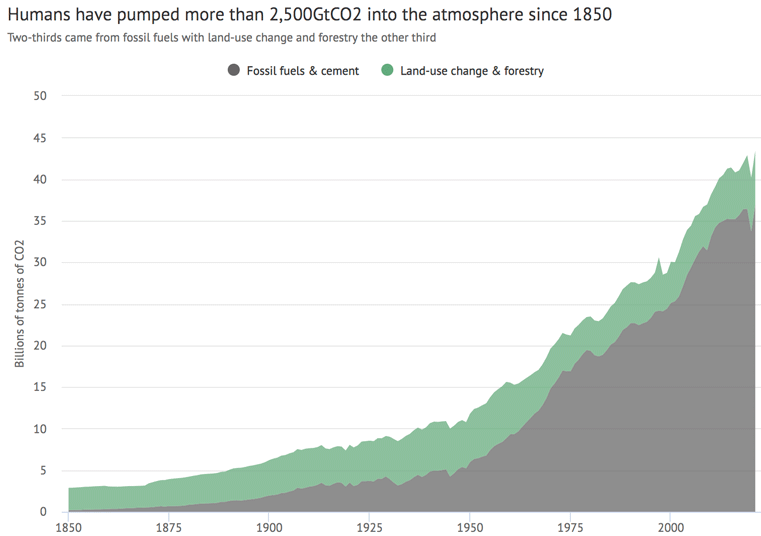
Even if we do manage to prevent industry from pumping CO2 into the atmosphere. The average earth temperature will still rise for a while. 50° Celsius daytime shade temperature has just been recorded in Turkey. This is well above the operating temperature of the human body, which works in a narrow band of 36° - 37.5° Celsius. That is best achieved with daytime shade temperatures of 18° - 24° Celsius. If high temperatures are accompanied by high humidity, then the situation is much worse, as the body is unable to sweat out the heat. Great news for air conditioning companies, but bad news for humanity.
In summary, non-linear logistic growth is normal for living things and nature has a way of ensuring that the carrying capacity of an environment is not surpassed, but humans have little or no respect for nature and could well be the first species to extinct itself.